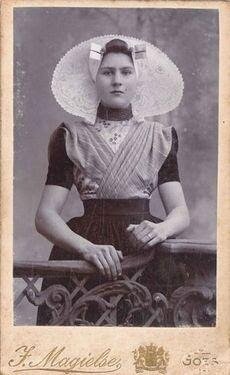Caps Galore—Dutch Traditional Caps and their many Personalities
Dutch traditional caps. Probably about 0.01% of people who read that phrase will be excited by those exact words (which is likely a gross overestimation). This weirdly specific topic is something that has always captured my attention. I have seen many pictures of my own family members wearing them, and the caps’ interesting shapes just keep making me want to learn more. I finally decided to dive into it, now that I have the opportunity to share it with other fashion history enthusiasts. In all honesty, I can’t say I expected to find much interesting or useful information—but let me tell you, I couldn’t even have imagined the tsunami of information that I had coming my way. In this article, I’ll be looking at three of the most unusual shapes that I have found.
Now, for some general info on Dutch traditional costume. It is actually highly unusual for people to still wear it; there are very few people left that still wear their regional costume, and they’re usually older women. There are some occasions, like national festivities, where others will wear them, but it is not very common at all.
Zuid-Beveland, Zeeland
I wanted to start out with what I consider to be my favourite shape out of all of the caps. If you’ve seen Jurassic Park, you might be somewhat familiar with the shape of this one. These caps are, mildly put, spectacular. This type of cap is characterized by its huge silhouette surrounding the head, which could even show others what religion you were part of! For Catholics, it was the more trapezoidal shape that showed where their religious interest lay. Protestant women wore a rounded, oval shape around the head, which they would call “shell-shaped”. Both are shown in the pictures below!
These big, stiffened, lace caps were usually only worn on Sundays or special occasions, leaving them with a cute, but simple broderie cap underneath during the week. Because pictures were, of course, considered to be special occasions, we are luckily still able to enjoy a myriad of pictures of girls and women wearing the full-on Sunday-glam caps.
Looking at these pictures, we also cannot ignore the large golden squares sticking out from behind the ears. They are gorgeous, but also look an awful lot like fancy side-view mirrors. These are called “oorijzers”—in English “ear-irons”. Sadly enough, I wasn’t able to figure out why exactly these were worn! Either way, it looks stunning.
Hindeloopen, Friesland
Travelling to the North of the country, we find Hindeloopen, with caps unlike any I’ve seen in the rest of the country. Inspired by their inhabitants’ world travels, they combined both colourful Indian patterns and older Dutch elements into a whole new style. Their colourful patterns made them stand out from other traditional, lacy, white caps. Interesting as well is the fact that you could distinguish between married and unmarried women by their caps. Unmarried women simply wore checkered caps. Married women wore these as well, but wore a “fôrflechter” on top, which is the cylindrical hat we can see in the picture below, on the woman on the left. Women would also sometimes wear a golden “needle” on the forehead—to be seen in the painting.
I’m so intrigued by these caps, as I had actually never seen them before doing my research for this article. Can’t say I’m disappointed with the discovery though, they are absolutely glorious. However, I have some burning questions; how on Earth did these stay attached to their heads? How heavy must it have been? I can only give huge respect to these women—as well as to their neck muscles.
Volendam, Noord Holland
Lastly, I wanted to touch upon the traditional cap of Volendam. This is arguably the most famous type of cap in the Netherlands. We see thousands and thousands of tourists put on this cap for a cute picture to remember the experience later. The Volendammer women’s most famous type of cap consisted out of two parts; the under-hat “ondermuts” and the “hul”. The former is actually a super cute black pointy hat, much like that of our stereotypical witch, just without the rim. The latter is the well-known white, lacy cap with the two sides sticking forwards and upwards, as you can see in the pictures.
This cap is honestly so cute! The little pointy parts with the stunning lace are super adorable. Even though this is pretty much the stereotype for Dutch costumes, I can’t deny that they just look amazing—and I also can’t deny that I’m one of the perpetrators of wearing it for a tourist picture in my own country (not providing pictures for that one though).
I also want to address that these caps actually represent a lot more than may seem at first glance. They can show where you’re from, your religion, your marital status, your job, how well-to-do you are, among other things. These traditional dresses used to be quite similar in large parts of the country but started changing during the mid-19th century, to the point where most regions would have their own specific caps, skirts, tops and jewellery. Usually, most villages would even have their differences. Some would take inspiration from city-folk or elite groups (or as people from Hindeloopen, from the other side of the world), other places would keep more to themselves.
Honestly, I went into this article horribly underestimating the extremely detailed history of these seemingly simple caps and their storytelling functions. I always thought no one really cared about them anymore, so not a lot of information would be available. Boy, was I wrong. There are still numerous groups, archives and hobbyists who adore talking about and dressing in klederdracht, which I’m extremely happy about. It’s such an interesting, niche part of history that can even help us understand how class, religious and other differences were put into practice in costume.





